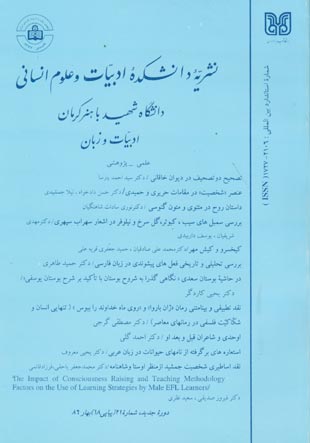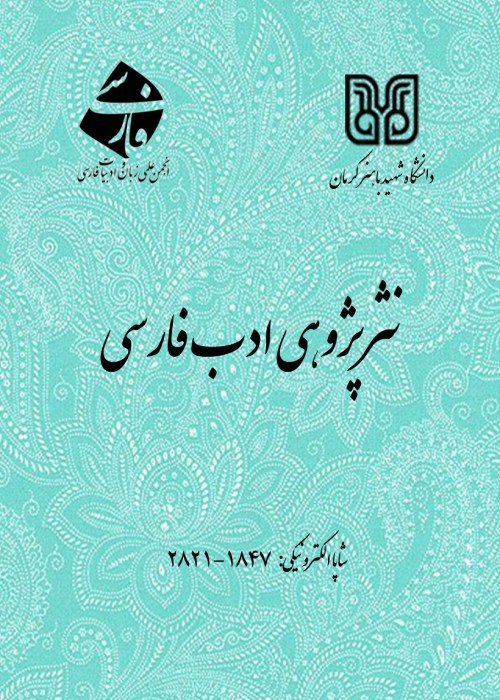فهرست مطالب

نشریه نثر پژوهی ادب فارسی
سال نهم شماره 18 (بهار 1386)
- 350 صفحه، بهای روی جلد: 5,000ريال
- تاریخ انتشار: 1386/09/20
- تعداد عناوین: 13
-
-
صفحه 45
-
صفحه 85
-
صفحه 203
-
استعاره های برگرفته از نامهای حیوانات در زبان عربیصفحه 235حیوانات از آغاز آفرینش تاکنون جایگاه مهم و حضوری قوی در ابعاد رفتاری، گفتاری و نوشتاری داشته اند. درواقع، کسی که در فرهنگهای لغت عربی تامل می کند، وجود تعداد زیادی از واژگان که از زمینه اصلی خود دور شده، و در معانی جدیدی به کار رفته اند،توجه او را به خود جلب می کند. این پدیده زاییده تصادف نیست بلکه نتیجه حضور فکری و وجودی حیوان در اذهان اهل لغت است. بدیهی است که قالبهایی که حیوان در آن حضور و وجود محسوس ومسلط دارد برای انسان در خلق دیگر واژگان تجسم یابد. به رغم توجه لغت شناسان به این نوع واژگان، متاسفانه بخش بسیار مهمی از آن، یعنی کاربرد استعاری واژگان برگرفته از نامهای حیوانات مورد غفلت قرار گرفته است. در این مقاله مجموعه وسیعی از نامهای حیوانات که در به وجودآمدن واژگان جدید در زمینه های اجرام آسمانی، گیاهان، مصنوعات دستی و نیز نامگذاری افراد و قبایل تاثیرگذار بوده به تفصیل بررسی شده است.
کلیدواژگان: واژه گزینی حیوانات در عربی، است، عاره در نامهای حیوانات، گ، یاهان، اج، رام آسم، انی و مصنوعات دستی -
صفحه 1
-
Page 1Although research on the works of Khaghani has had an increasing trend, the reevaluation of his works and a new correction of these works seem to be almost inevitable. The purpose of the present study is the correction of two differentversions in his `Habsie ode`. The methodology of this study is based on library method. Hence all the available corrections of Khaghani`s works and the works of famous Iranian scholars in this field regarding these poetical works have been used. The conclusion shows that one can have a new understanding of these poems, and, subsequently, one can have a more authentic knowledge of the works of this great poet.
-
Page 17Hariri and Hamidi’s Maghamat are considered as prose and story works in ancient Arabic and Persian literature. These two story collections, from the viewpoint of having fictionelements and good characterization, enjoy so much strength and acceptability, which are equaled by modern short stories. One of most important fiction elements is “character” which has a significant role in Hariri’s Maghamat.Comparison between methods of characterizing and analyzing of all characters, in these two Maghamats, causes to introduce the literary value of these two works, and shows the relationship between Arabic and Persian literature.
-
Page 45The mystical works of Islamic period reveals gnostic thoughts as a mirror. To survey the gnostic views on the soul, this article enjoys Nag Hammadi texts and Mathnavi of Molavi.The event of it’s descent to material world, captivity and preoccupation in prison of ignorance and the path of salvation that is to acquire knowledge (gnosis) which comes from God to man. This shows that Molavi’s teachings are similar to gnostics and maybe indicating the influence of gnosticism on sufism.
-
Page 59Symbol is a literary technique which has drawn the attention of many poets. In its general meaning, symbol is the representation and explanation of something else. Symbol’s important characteristic is its ambiguity, vagueness, lack of details and lack of direction. It means that in symbolic language, desire and intention, is not the surface and figure of speech, but it’s a concept, beyond the surface and in a deeper sense. Sohrab Sepehri, one of the contemporary poets, has used symbols in his poems and this has given it ambiguity and complexness. In this artcle, the effort was to study anddescribe symbols in Sohrab’s poems as far as possible, to study his worldview.
-
Page 85The Signs of the Mithraism which prevailed in Iran before the emerging of Zoroaster are observed in literary works and especially epic poems. The evidences show the relationshipbetween Pishdadian and Kianian dynasties and the “Mehr cult”. The kings of these two ancient dynasties worshipped the moon and the sun and elements generalities before Zoroaster according to Birooni’s Asar-al-Baghiyeh.By studying of Ferdowsi’s Shahnameh and some Pahlavi texts one can deliver an evidence based on the relationship between kings such as: Fereidoon; Jamshid; Siavosh and Keykhosrow and “Mehr cult”. Among these the story of Keykhosrow is related to the birth and ascension of Izad Mehrs myth. The birth of this king who is considered as the most good-natured fabulous king of Iran at a dark night and his birth and growth among shepherds is related to “Mehr” in terms of shepherds’ care and presence. His prayer before the sun and his washing customs before praying resemble Mehr rituals. Also hisascension to sky and the scared dinner customs or “Izad Mehr” ascension are the facts which refer to Mithraism.
-
Page 113Prefix verbs are form a category of verbs in the Persian language. Such verbs have been in use since the old Persian era, but their frequency has had a downward trend in the DariPersian. The prefixes in these verbs, which constitute the nonverbal component of the verb group, mainly designate direction and sometimes emphasize the meaning and theoccurrence of the verb, or they sometimes create a new meaning in the verb group. Through time, the prefixes in such verbs have been replaced by adverbs, verb complements, or non-verbal components in noun or adjective groups.
-
Page 137The Bustan of sa’adi is a Persian literary masterpiece on which numerous commentaries have been written. Although they all contribute to better introduction of the Bustan andsa’adi, they have hardly done justice to the high station of this poet. Hence, the Bustan has hardly received the true critical attention it deserves. This shortcomings concern content notes, lexical, syntactic, and rhetorical elaborations. The present article concerns critical analysis of the shortcomings observed in the existent commentaries of the Bustan.
-
Page 167An epistemological approach to the new era shows that the modern man has fundamental difference with the classic man. The phenomenon of human alienation and skepticism and the dominance of the principal of probability over certainty in belief, speech and behavior are but a few of modern man’s characteristics not depicted in the past. These are reflected in the art and letters of the century, particularly in the literarynovel. The two novels under study here i.e. “Jean Barva” by Du Gar and “Kiss the Beautiful Face of God” by Mostafa Mastoor, have been written in different places, cultures and languages. What they have in common is a critical look at the fate of the modern man who views objective and even sacred phenomena with a skeptical eye. While Mastoor’s is a religious-philosophical novel,Du Gar’s is purely philosophical with a rationalistic view which questions the issue of religion. The author analyzes the element of character in these novels contrastively and concludes that while Mastoor is successful in design, plot and narration, yet it has less depth in arrangement and conclusion in comparison to Du Gar’s.
-
Page 203The quality of Interaction (literary influence and impressions) in poetry is one of the interesting subjects in Literary Criticism. Poetic research, from this point of view reveals the time of creation and the extent of re-creation, the innovation manner and the perfection of literary contexts to give the readers a better insight.
-
Metaphors Derived from Animal Names in Arabic LanguagePage 235Animals have had an important place from the dawn of creation to now in different aspects of human language. Those who ponder in Arabic dictionaries, find many a words that are ar from their main sphere of meaning and are used in a new context. This is no coincidence. It is the mental and actual presence of the existence of animals near the terminologists. No wonder that in word coinage, man takes advantage of forms embodied with animal presence. In spite of specialists’ attention to all kinds of terms, an important field i.e. metaphors derived from animal names has been thrown into oblivion. This article presents a large set of animal names used in naming celestial bodies, plants, handicrafts, tribal names and proper names.The author hopes to release another article on the same metaphors in Farsi language.
-
Page 273Mythological criticism is one of the main methods of contemporary literary criticism that has been based on findings of contemporary psychology and particularly theories of Carl Gustav Jung, the famous Swiss psychiatrist,and his personality theory. Analytic psychologyand its formation is in continuity theory that has been created on Sigmund Freud’s psychoanalysis theory (Austrian psychiatrist). The paper depicts the formation of priest-king pattern in personality of Jamshid, his assimilation with Manna (Fares), his psychic inflation, and gloriousness, instituting of goldenage and utopia (Var-e-Jamkard), and reasons of his sin and his extremity destroying, in Avesta and Shahnameh. Then, it presents the reader with archetypical criticism andchange cycles of the myth.


